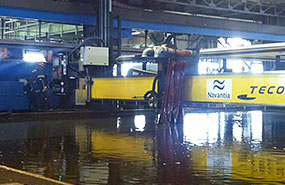NAVANTIA begins the construction of the Suezmax oil tankers at Puerto Real
25 April 2016 | Puerto Real (Cádiz)

- From now on, the rhythm of work will significantly increase with the goal of delivering the first unit at the end of next year
- The construction of the ships starts thanks to the agreement in force between Cepsa and Grupo Ibaizábal
- The construction of the 4 ships will entail about 3,100 jobs, among direct, indirect, and induced jobs
- Mr. José Manuel Revuelta: “Today is an important date for the Spanish industry, because after two decades, oil tankers are being built once again in Spain”
NAVANTIA has begun today the construction of the first of the Suezmax oil tankers for Grupo Ibaizábal. The ships will be built to a large extent in the Puerto Real shipyard, while some of the blocks will be built in Ferrol. The first ship will be delivered at the end of next year, and the contract will entail around 3,100 jobs, including direct, indirect and induced jobs.
The two first ships will become part of Cepsa’s fleet under the time charter mode. The construction of the ships is part of the agreement which Cepsa concluded with Ibaizábal for renovating its fleet, incorporating the most advanced optimizations, both in energy saving and for cargo transport and safety.
The ceremony was attended by South Korea’s Ambassador, Mr. Park Hee-Kwon; by DSEC’s Chairman, Mr. Man-Soo Kim; by Grupo Ibaizábal’s Chairman, Mr. Alejandro Aznar; by the Head for Communication and Institutional Relations in Cepsa, Mr. Iñigo Díaz de Espada, and by NAVANTIA’s Chairman, Mr. José Manuel Revuelta.
On December 2015 the class society Lloyd´s Registers certified the 6 keels, fulfilling one of the contractual requirements that the keels be laid by the end of 2015, in order to meet the current international regulation about the construction of this kind of ships.
From now on, with the continuous reception of materials from DSEC in South Korea, the rhythm of work will increase considerably. The first of the ships will be delivered at the end of 2017. Currently work is undergoing on achieving the fifth and sixth oil tankers.
The construction of each ship will entail around 725,000 hours of work, that is, that for the first 4 ships the volume of work will be of about 3 Million hours of work for NAVANTIA’s shipyards in the Bay of Cadiz and in the Inlet of Ferrol and for the ancillary companies. The transaction will generate direct, indirect and induced jobs for more than 3,100 persons. From this figure, more than 1,600 are induced jobs.
A competitive business model
The ships are being built in Spain at the international market price for this kind of ships, providing stability to NAVANTIA’s workload, fostering job and promoting the domestic industry.
NAVANTIA’s Chairman, Mr. José Manuel Revuelta, pointed out that “today is a very important date for NAVANTIA and for the Spanish industry, because after two decades oil tankers are being built once again in our country”. He added that “the workload situation of the Company has changed, and it is consolidating its transformation process for becoming a competitive and sustainable shipbuilding company, mostly of a military nature but also civil, international and capable of production diversification”. Mr. Alejandro Aznar highlighted the commitment shown by NAVANTIA’s management team and by its works council with the project’s success. South Korea’s Ambassador stated that this Spanish-Korean collaboration will benefit both parties.
The contracts mean the profitable return of the Company to oil tanker construction after a very long time without building ships of this kind. The contracts have been achieved thanks to the offer of a very competitive product, the result of the agreement reached with DSEC, an engineering company of Daewoo.
DSEC provides its experience in the construction of this kind of ships, a highly consolidated design, preventing the risks attached to the beginning of a new project. The agreement includes all DSEC’s design and DSEC’s logistical and supplies chain, although always giving the opportunity and priority to the Spanish companies which offer competitive prices.
This new business model allows NAVANTIA to compete in the global market, offering a competitive price and an adequate term for the customer’s requirements, without the risks attached to the start of a new project.
Suezmax main characteristics
The Suezmax ships are thus called because their measurements allow them to navigate through the Suez Canal. Their most significant dimensions are:
- Deadweight: 156,000 Tons
- Length: 274 meters
- Beam: 48 meters
- Steel used: 20,144 Tons
About NAVANTIA
NAVANTIA constitutes a world reference in the design, construction and integration of warships with a high-technological content, as well as ship repairs and upgrades. Besides, its activity lines include the design and manufacturing of combat and command and control systems, integrated platform management systems, firing control systems, propulsion engines and the Life Cycle Support for all its products. Although its main activity is in the naval field, NAVANTIA also designs and manufactures systems for the Army and the Air Force.
NAVANTIA belongs to Grupo SEPI, a corporate holding which includes a total of 16 state-owned companies in which it has direct, majority shareholding participations, with a workforce of around 73,000 professionals in 2014; the Spanish state-owned television and radio corporation, Corporación Radiotelevisión Española, which is attached to SEPI, and one public foundation. Equally, SEPI has direct minority shareholdings in a further ten companies, and indirect shareholdings in more than one hundred companies.



